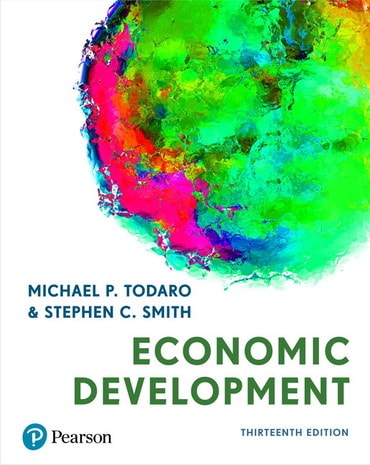
- Michael P. Todaro |
- Stephen C. Smith |
Title overview
Economic Development, the leading textbook in this field, provides your students with a complete and balanced introduction to the requisite theory, driving policy issues, and latest research. Todaro and Smith take a policy-oriented approach, presenting economic theory in the context of critical policy debates and country-specific case studies, to show how theory relates to the problems and prospects of developing countries.
Hallmark Features
The hallmark approach, shaped by the authors’ personal experience and extensive research:
- Teaches economic development within the context of country-specific examples so that theory is demonstrated through real-world issues.
- Adopts a problem- and policy-oriented presentation to foster students’ ability to understand contemporary economic problems and to reach independent and informed conclusions.
- Uses the best and most recent available data and the appropriate theoretical tools to illuminate common problems of developing countries.
- Focuses on a wide range of developing countries, not only as independent nation-states but also in relation to one another and in their interactions with rich nations.
- Recognizes the necessity of treating the problems of development and underdevelopment from institutional, structural, and market perspectives.
- Views development and underdevelopment in both domestic and international contexts, stressing the increasing interdependence of the world economy.
- Considers the economic, social, and institutional problems of underdevelopment as closely interrelated and requiring coordinated solutions at local, national, and international levels.
- Coverage of topics is structured to allow instructors to adapt lecture topics based on their individual course.
- Essential principles of economics relevant to understanding development problems are highlighted in boldface and are explained in detail where appropriate.
- The material is sufficiently broad in scope and rigorous in coverage to be used in any undergraduate and some graduate development economics courses.
Features
- Country-specific Case Studies at the end of each chapter reflect and illustrate specific problems discussed in the chapter.
- Voices of the Poor boxes give students perspective on the issues faced by citizens in developing and underdeveloped nations.
The text is organized into three distinct parts:
- Part One focuses on the nature and meaning of development and underdevelopment, and its various manifestations in developing nations. The growth experience of now-developed countries is examined, four classic theories of development are presented, and recent development models are introduced.
- Parts Two and Three focus on major domestic and international development problems and policies, such as economic growth, poverty and income distribution, population, migration, and urbanization.
- The book concludes with the authors’ look ahead at key emerging issues in economic development.
New to this edition
- New or thoroughly updated cases at the end of each chapter
- New in-depth case study of economic development in India
- Expanded, thoroughly updated country cases of China and Brazil
- Comparative cases: Burundi and Rwanda; Uganda and Kenya; Mauritius and Botswana
- Sustainable Development Goals: New section on goals, progress, and challenges
- Climate change: Regional predictions; mitigation, resilience and adaptation policy, part of a full chapter on Environment and Development
- Convergence: Perspectives on the 200-year income divergence, plus the recent shift toward (re)convergence
- Behavioral Economics: Findings for poverty; physical and mental health
- Analysis NGOs and civil society roles, as well as of private and public sector
- Inclusive growth diagnostics
Table of contents
- 1 Introducing Economic Development: A Global Perspective
- 2 Comparative Economic Development
- 3 Classic Theories of Economic Growth and Development
- 4 Contemporary Models of Development and Underdevelopment
- 5 Poverty, Inequality, and Development
- 6 Population Growth and Economic Development: Causes, Consequences, and Controversies
- 7 Urbanisation and Rural-Urban Migration: Theory and Policy
- 8 Human Capital: Education and Health in Economic Development
- 9 Agricultural Transformation and Rural Development
- 10 The Environment and Development
- 11 Development Policymaking and the Roles of Market, State, and Civil Society
- 12 International Trade Theory and Development Strategy
- 13 Balance of Payments, Debt, Financial Crises, and Sustainable Recovery: Cases and Policies
- 14 Foreign Finance, Investment, Aid, and Conflict: Controversies and Opportunities
- 15 Finance and Fiscal Policy for Development
Author bios
Michael P. Todaro was Professor of Economics at New York University for eighteen years and Senior Associate at the Population Council for thirty years. He lived and taught in Africa for six years. He appears in Who's Who in Economics and Economists of the Twentieth Century. He is also the author of eight books and more than fifty professional articles.
Stephen C. Smith is Professor of Economics and International Affairs at George Washington University. He received his PhD in economics from Cornell University. Smith is the author of Ending Global Poverty: A Guide to What Works, co-editor of NGOs and the Millennium Development Goals: Citizen Action to Reduce Poverty, and author or co-author of some three dozen journal articles.